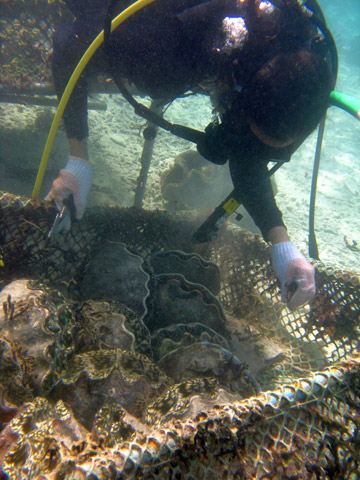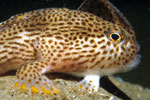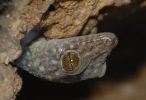Everyone knows the tiger, the panda, the blue whale, but what about the other five to thirty million species estimated to inhabit our Earth? Many of these marvelous, stunning, and rare species have received little attention from the media, conservation groups, and the public. This series is an attempt to give these ‘forgotten species‘ some well-deserved attention.

Tridacna derasa a ‘forgotten’ giant clam species, also being cultured by the Giant Clam Project (Marine Science Institute) under Suzanne Licuanan. Photo by: Ardea Licuanan.
The first time I ever saw a giant clam was at a ride in Walt Disney World’s Magic Kingdom. My family and I piled into the Nautilus submersible at the 20,000 Leagues Under the Sea: Submarine Voyage and descended into the playtime depths. While we saw sea turtles, sharks, lobsters, mermaids, and even a sea monster, the creature that lingered in my mind most was the giant clam, raising and closing its pearly shell in the weedy abyss. Of course, none of these aquatic wonders were real—they were animatronics—but to a child with a vivid imagination they stirred within me the deep mystery of the boundless ocean, and none more so than that monstrous clam with its gaping maw.
The Disney ride is based off the 1954 film version of Jules Verne’s classic ocean adventure novel, 20,000 Leagues Under the Sea. In that book, the giant clam also makes an appearance: the enigmatic Captain Nemo, who cruises the ocean’s waters in his high-tech submarine, takes guests to an underwater cave to show them one of the marvels of the marine world.
“[Captain Nemo’s] hand indicated an object that I hadn’t yet noticed. It was an oyster of extraordinary dimensions, a titanic giant clam, a holy-water font that could have held a whole lake, a basin more than two meters wide,” author Jules Verne wrote in 1870.
 Suzanne Licuanan diving to check on a cage full of cultured giant clams. Photo by: Ardea Licuanan. |
For those, like myself, who grew-up deep inland, far from any wave-crested seashore, the world’s giant clams have retained the exoticism captured in Verne’s novel and Walt Disney’s ride. They are underwater giants that seemed to represent the very wildness—and wonderful weirdness—of the oceans. Sure, they may not make the same awe-struck impression as say a blue whale or a giant squid–which has the most memorable appearance of any sea entity in Verne’s novel—but they still retain considerable power over the landlocked imagination to conjure up faraway places and alien ecosystems, full of giants.
However, for those who grew up near giant clams—when they were just a dive away—the species becomes something different altogether.
“In the Philippines, giant clams are known locally especially to coastal dwellers, having traditionally collected clams for food, and shell craft; and also to visitors of these coasts, aquarists, and environmentalists,” Dr. Suzanne Mingoa-Licuanan, head of the Giant Clam project at the University of Philippines, says.
The giant family
There are ten known giant clam species: two in the Hippopus genus and eight in the Tridacna genus. The world’s biggest is Tridacna gigas, which translates literally into ‘giant.’
Verne’s narrator, one Professor Pierre Aronnax, describes this “phenomenal mollusk” as weighing 660 pounds (300 kilograms) with 33 pounds (15 kilograms) of meat. He notes wryly, “You’d need the stomach of King Gargantua to eat a couple dozen.” Although no clam has ever been found in the wild as large as the one invented in Verne’s mind—nor could a giant clam survive in the darkness of a cave as described in the novel—the giant clam still lives up to its name.
The world’s biggest specimen of Tridacna gigas was found off the coast of Sumatra. The shells alone weighed 507 pounds (230 kilograms) and measured about 4.5 feet (1.4 meters) across. The heaviest paired shells ever found weighed 579.5 pounds (263 kilograms), dwarfing a female grizzly bear. These prodigious clams are also long-lived: at least over fifty years. The other nine species are smaller, but still large enough to be dubbed giants.
 Giant clam, Tridacna gigas, on the Great Barrier Reef. Photo by: Jan Derk. |
Ecologically, giant clams are not dissimilar from coral reefs. Both giant clam and corals have created a symbiotic relationship with algae known as zooxanthellae, and some zooxanthellae species have evolved to work with both species. The clams provide zooxanthellae with a good, safe place to soak up sunlight between the massive mantles, while the clam feeds off the zooxanthellae’s byproducts and sometimes eats a few of the algae as well.
Mingoa-Licuanan explains that this process provides nutrient-recycling for the whole ecosystem.
“Nitrogenous wastes and photosynthetic by-products are exchanged between the clam and its zooxanthellae. Through zooxanthellar photosynthesis, carbon dioxide is removed from the water, and the surrounding water gets oxygenated. The clam zooxanthellae also remove nitrogenous molecules from the water,” she explains, all of which helps keep the marine waters healthy and diverse.
Although the bulk of their food comes from zooxanthellae, giant clams also siphon in water, feeding on plankton, which Mingoa-Licuanan says “helps clarify the water.”
But, in addition to being a general recycler for the marine ecosystem, giant clams provide specific aid to some species.
“A cluster of clams provides shelter or refuge to seaweeds, small vertebrates (e.g. fishes) and invertebrates such as gastropods, crustaceans, and sea urchins. The shells also serve as substrates for attached organisms, including seaweeds, sea squirts, sponges, hard and soft corals, tubicolous worms, and boring bivalves,” Mingoa-Licuanan explains says, all of which, “enhance[s] local biodiversity.”
Attraction and overexploitation

A bed of true giant clams, Tridacna gigas, cultured and reared in Bolinao, Pangasinan, Philippines by the Giant Clam Project, Marine Science Institute. Photo by: Ardea Licuanan.
Giant clams, however, are not just important for marine biodiversity: people have also used them for centuries. Their meat is eaten and their shells made into decorative items.
“The first giant clam that I saw was a crocus clam (Tridacna crocea). It was embedded among coral rock and rubble. I was stunned to see its beautiful purple mantle,” says Mingoa-Licuanan. Giant clam mantles are not drab, but brilliantly colored, like undersea psychedelic rainbows.
In fact, even Jules Verne, who had probably never seen a living giant clam, understood the attraction of the animal. He has Captain Nemo decorate his ship’s lounge with a giant clam shell.
“In the middle of the lounge, a jet of water, electrically lit, fell back into a basin made from a single giant clam,” Verne writes.
Likely, clam harvesting was sustainable for centuries until, Mingoa-Licuanan says, “foreign commercial fishers” began invading Pacific waters clamoring for giant clams. They were taken from the waters not just for food and crafts, but also for the aquarium trade and for Chinese Traditional Medicine, which believes that the clam’s adductor muscle has aphrodisiac powers.
But by the end of the Twentieth Century many giant clam species had become overharvested and had even gone locally extinct in some regions. Today, four of the giant clam species are listed as Vulnerable by the IUCN Red List, including Tridacna gigas. Others are listed as Lower Risk or Conservation Dependent, but all of clam species need updating since the family hasn’t been evaluated for over fifteen years.
Conservationists, like Mingoa-Licuanan, responded to the giant clam decline with research and conservation efforts.
“Scientists from Australia, Solomon Islands, Palau, Philippines, and several Pacific island nations collaborated to study giant clam biology, culture methods, and giant clam trade in the mid-1980s. Resulting programs on giant clam reseeding […] have popularized giant clams for conservation, education, and reef management,” she says.
The research resulted in successfully breeding giant clams in nurseries. The University of Philippines’ Marine Science Institute is currently rearing giant clams which, once large enough, are reseeded in marine protected areas. Following this, Mingoa-Licuanan says, the clams are “monitored by trained stewards.” Once a giant clam is returned to its habitat, it facilitates the re-wilding of giant clams through spawning.
But, Mingoa-Licuanan adds, much work remains to be done.
“Recruitment areas outside of marine protected areas need to be protected from clam collection. […] Also, although conservation awareness among local communities has improved over the years, there is still a need to disseminate information to more communities, particularly on the greater value of having a live clam on the reef, compared to a dead one.”
For the wider public, Mingoa-Licuanan says people can help the species by forgoing giant clam meat and not buying crafts made from shells or live giant clams for aquariums.
“People should learn more about giant clams, how they live, and how man benefits from live giant clams,” she says. “They should allow their children and other young people opportunities to know about this information as well. ”
However even if conservationists succeed in bringing back and protecting giant clams, a new threat is on the horizon. Scientists worry that climate change and ongoing ocean acidification, both of which are caused by burning fossil fuels, could have long-term impacts on the giant clam family.
Jules Verne: 19th century conservationist?
The encounter with the giant clam in 20,000 Leagues Under the Sea ends with Captain Nemo leaving the monster mollusk alone, since the clam is molding a pearl whose “globular shape, perfect clarity, and wonderful orient made it a jewel of incalculable value.” Nemo intends to harvest the pearl one day, but is patiently allowing it to grow. Although Verne is a bit off-track here—unlike oyster pearls, clam pearls are neither spherical nor clear—he provides an intriguing metaphor for the giant clam’s current plight. If we can recognize the giant clams’ real pearls—as nutrient-recyclers, micro-habitats, and gargantuan beauties—perhaps, like Nemo, we will learn it is better to admire and leave them be than exploit them for short-term gain.
“Supporting a live giant clam means support for humanity and the environment,” concludes Mingoa-Licuanan.
Two decades after viewing imitation giant clams at Walt Disney World, I got the chance to snorkel with real ones off the coast of Borneo. Although I was older and wiser, the sense of mystery, wonder, and adventure returned to me again as I beheld these imperiled mammoths beneath the sea. They rested on the clear sea bed like brilliantly-draped sentinels, guarding the diversity and beauty of the endangered tropical oceans.

Giant clam, Tridacna gigas, on the Great Barrier Reef. Photo by: Jan Derk.
_Timor.568.jpg)
Giant clam species, Tridacna squamosa, in Timor. Photo by: Nick Hobgood.

Tridacna gigas in Timor. Photo by: Nick Hobgood.
Related articles
Forgotten species: the wild jungle cattle called banteng

(01/31/2012) The word “cattle,” for most of us, is the antithesis of exotic; it’s familiar like a family member one’s happy enough to ignore, but doesn’t really mind having around. Think for a moment of the names: cattle, cow, bovine…likely they make many of us think more of the animals’ byproducts than the creatures themselves—i.e. milk, butter, ice cream or steak—as if they were an automated food factory and not living beings. But if we expand our minds a bit further, “cattle” may bring up thoughts of cowboys, Texas, herds pounding the dust, or merely grazing dully in the pasture. But none of these titles, no matter how far we pursue them, conjure up images of steamy tropical rainforest or gravely imperiled species. A cow may be beautiful in its own domesticated sort-of-way, but there is nothing wild in it, nothing enchanting. However like most generalizations, this idea of cattle falls to pieces when one encounters, whether in literature or life, the banteng.
Forgotten species: the rebellious spotted handfish

(07/12/2011) Evolution is a bizarre mistress. In her adaptation workshop she has crafted parrots that don’t fly, amphibians with lifelong gills, poison-injecting rodents, and tusked whales. In an evolutionary hodge-podge that is reminiscent of such mythical beasts as chimeras and griffins, she has from time-to-time given some species’ attributes of others, such as the marine iguana who is as happy underwater as a seal, the duck-billed platypus that lays eggs like a reptile, and the purple frog that has a lifestyle reminiscent of a mole. Then there’s one of her least-known hodge-podges: the fish who ‘walks’ with hands instead of swimming.
Forgotten species: the endearing Tenkile tree kangaroo

(05/03/2011) With their long snout, furry body, soft eyes, and, at times, upright stance, tree kangaroos often remind me of the muppets. Of course, if there were any fairness in the world, the muppets would remind me of tree kangaroos, since kangaroos, or macropods, have inhabited the Earth for at least 5 million years longer than Jim Henson’s muppets. But as a child of the 1980s, I knew about muppets well before tree kangaroos, which play second fiddle in the public imagination to their bigger, boxing cousins. This is perhaps surprising, as tree kangaroos possess three characteristics that should make them immensely popular: they are mammals, they are monkey-like (and who doesn’t like monkeys?), and they are desperately ‘cute’.
Forgotten species: the plummeting cycad

(12/06/2010) I have a declarative statement to make: cycads are mind-blowing. You may ask, what is a cycad? And your questions wouldn’t be a silly one. I doubt Animal Planet will ever replace its Shark Week with Cycad Week (perhaps the fact that it’s ‘animal’ planet and not ‘plant’ planet gave that away); nor do I expect school children to run to see a cycad first thing when they arrive at the zoo, rushing past the polar bear and the chimpanzee; nor do I await a new children’s book about a lonely little anthropomorphized cycad just looking for a friend. In the world of species-popularity, the cycad ranks pretty low. For one thing, it’s a plant. For another thing, it doesn’t produce lovely flowers. And for a final fact, it looks so much like a palm tree that most people probably wouldn’t know it wasn’t. Still, I declare the cycad to be mind-blowing.
Forgotten species: the nameless giant forest snail

(08/04/2010) All species known to science are granted a Latin name. While this naming system is beneficent to researchers, Latin names—sad to say—don’t really capture the public’s attention anymore. Fortunately most species also have common names—the red fox, the pileated woodpecker, the Asian elephant, and so on. Some of these names even end up being quite wonderful: like the dusky dolphin (love the alliteration), the strawberry poison dart frog (points for creativity), the blobfish (if you see a photo you’ll know why), and my all-time favorite: the goliath bird-eating spider. Although this name is slightly redundant (any spider that eats birds is goliath), I wouldn’t change it for anything. However, some species, especially those less ‘charismatic’ ones, never get beyond their Latin name. Such is the fate of a giant forest snail known to researchers as Archachatina bicarinata and to the rest of us as…well nameless. But this begs a question: how do we save a species if we don’t even name it?
Forgotten species: the cryptic Jerdon’s courser

(07/06/2010) According to my Oxford English Dictionary, ‘cryptic’ means: ‘secret, mystical; mysterious; obscure in meaning; enigmatic’. This is the perfect adjective for the rare Indian bird, Jerdon’s courser (Rhinoptilus bitorquatus). ‘It is not so easy to spot as it is a small bird and when you show the torch it crouches and merges with the surroundings. So we need very good trained eyes to look for them,’ Dr. P. Jeganathan recently told mongabay.com.
Forgotten species: the subterranean Gekko gigante
(04/08/2010) Travelers to tropical destinations are likely familiar with the gecko. Clinging to walls and ceilings of buildings—sometimes staring down at you from the bedroom ceiling or glancing at you quizzically from the bathroom door—the small adhesive-footed lizard could be aptly described in some tropical areas as ubiquitous. Despite the apparent commonness of some species, geckos are delightful lizards with round wide eyes, a thick gripping tongue, and of course that amazing knack of seemingly defying gravity with specialized toe pads. But not all geckos are as easily found—or as common—as those hanging out, literally, in a jungle lodge. The Gekko gigante, also known as the Gigante narrow-disked gecko, has been little- noticed by the public. Even scientists know little about the lovely gray-and-blue gecko beyond the fact that it lays its eggs on cool moist cave walls in two Philippine Islands.
Forgotten Species: the marooned pygmy three-toed sloth

(03/16/2010) Many people consider tropical islands mini-paradises: sanctuaries cut-off from the rest of the world. Some species flourish on islands for the same reason. With few predators and a largely consistent environment, once a species has comfortably adapted to its habitat there’s little to do but thrive. That is until something changes: like humans showing up. Changes in confined island ecosystems often have large and rapid impacts, too fast and too big for marooned species to survive.















